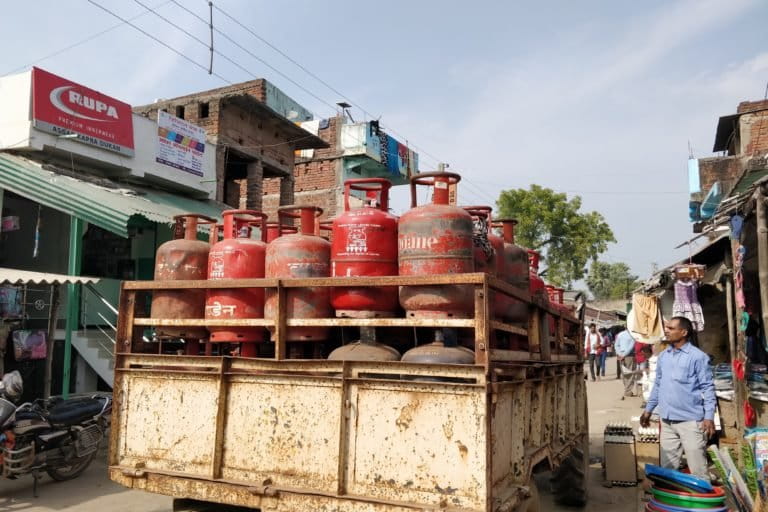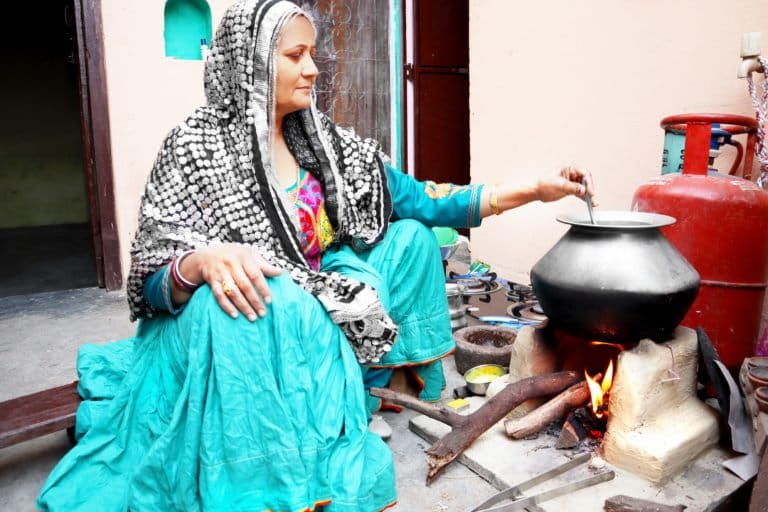- Studies have reported that the adoption of clean fuels such as LPG for cooking is associated with households where women are the primary decision-makers and have access to salaried work and control over household expenditure.
- Within the same economic class, a lower proportion of households from marginalised castes use LPG as their primary fuel.
- Social interactions or spillovers play a role in the adoption of LPG for cooking, particularly when households belong to women’s groups, development groups and agricultural cooperatives.
- Policies that empower women, support marginalised castes and leverage social spillovers could drive greater adoption of LPG for cooking.
Household air pollution caused mainly by the burning of solid fuels, including biomass—firewood, charcoal, coal, dung, and agricultural waste—and ambient air pollution are among the leading risk factors contributing to disease burden in India. Consequently, promoting a shift towards cleaner cooking fuels such as liquefied petroleum gas (LPG) has been a key focus of numerous initiatives.
Strides have been made in access to LPG, but many households still tend to use biomass for cooking and the practice of using multiple fuels, known as fuel stacking, is notable. Apart from cost concerns, socio-cultural influences have an impact on the adoption of LPG and reports have illuminated how household gender inequalities, disparities in the caste structure and social spillovers play a role.
Researchers call for policies to be tailored towards empowering women, assisting marginalised castes, and leveraging the power of social interactions, which could expand the adoption of LPG, especially in rural communities.
India’s government introduced the Pradhan Mantri Ujjwala Yojana (PMUY) in 2016—the largest clean cooking energy programme of its kind—in a bid to protect the health of women and children. By subsidising connections and providing a loan for the cost of LPG adoption, the scheme has been pivotal in transforming access to LPG with over 80 million connections provided to poor households in 715 districts.

Through the lens of gender
Several reports have unveiled how underlying gender inequalities within households are at play when it comes to deciding whether to switch to clean cooking fuels such as LPG. According to research from 2019, households where women participate in decision-making, are more likely to adopt LPG for cooking than households where men are the sole decision-makers. It was based on data from the 2014-2015 ACCESS (Access to Clean Cooking Energy and Electricity – Survey of States) survey, which covered over 8,000 families from rural areas in six of India’s most energy-deprived states—Madhya Pradesh, Uttar Pradesh, Bihar, Jharkhand, Odisha, and West Bengal.
Although the study did not probe the reasons for these findings, lead author Carlos F. Gould, doctoral student at Columbia University, believes that as primary cooks, women benefit from LPG but “if men making decisions do not fully appreciate the challenges of cooking with polluting biomass fuels, then they may not value acquiring LPG.”
However, when women are decision-makers, they understand the value of clean fuels—less smoky and faster cooking than with biomass—and may be more inclined to get LPG and use it regularly, Gould surmised. Programmes that improve women’s education and “promotion of their economic and financial well-being may well be critical in India’s transition to clean cooking,” he added.
A 2020 pan-India study that focused on women’s social and economic empowerment supports these findings. Using data from the India Human Development Survey (IHDS) of over 41,000 households conducted in 2004-2005 and 2011-2012, researchers concluded that households where women are engaged in stable and independent work, such as salaried jobs and have control over household expenditure decisions, are more willing to invest in clean fuels.

Sonalde Desai, professor at the University of Maryland and senior author of the study explained that most of the items households invest in are of interest to both men and women, but cooking fuel affects women more as they tend to be responsible for collecting firewood. As a result, “households, where women have a greater ability to skew the decision-making in their own favor,” are more likely to adopt LPG gas, Desai said.
“We expect that women who have their own income may have greater power to enforce expenditure that is of interest to them. Moreover, when women are able to earn an income, it makes their time more valuable and households may be more willing to choose labor-saving devices like LPG gas if the time women save can be invested in earning higher incomes,” added Desai.
Breaking gender stereotypes
Women also face obstacles in traveling to dealer locations with heavy cylinders, which leads to a delay in the purchase of refills, and forces them to stack cooking fuels, point out research analyst Shaily Jha and programme lead Sasmita Patnaik at the Delhi-based not-for profit research institution Council on Energy, Environment and Water (CEEW). In part, these hurdles are intertwined with the patriarchal setup of the household and limited decision-making power of women, they explained. According to the 2018 ACCESS survey, men decide on when to order a refill in more than two-thirds of households that have LPG.
As the burden of household chores such as cooking, cleaning and collecting firewood falls largely on women, Desai and her co-author propose that policies steered towards skill development and employment could accelerate the shift towards clean fuels.

Overcoming inequalities will require an interventionist approach that is gender-transformative, said Jha and Patnaik. “The narrative around the [PMUY] scheme reinforces inequalities of gender to the extent it promotes women as the primary cooks within households through its advertisements,” they added, urging schemes to “break the stereotype of women as the only users of LPG and include men in the conversation, both as users and beneficiaries.”
Caste inequities
The caste of the beneficiaries of the PMUY scheme also affects their LPG usage, according to a study by CEEW researchers, Jha and Patnaik, based on the results of the 2018 ACCESS survey. Inherent economic inequalities among castes can hinder the affordability of cylinders. They found that despite receiving subsidised LPG connections under PMUY, only 32 percent of Scheduled Caste (SC) households and 21 percent of Scheduled Tribe (ST) households reported LPG as their primary fuel compared to 49 percent of general households.
“Beyond the overall price of an LPG refill, the high upfront cost of the refill is a challenge for marginalised caste households,” said Jha and Patnaik. “For such consumers, direct debit of a subsidised cylinder value from the bank account or digital vouchers could be used to reduce the upfront expense.”
But the influence of caste goes beyond economic status. Even within the same category of economic status (based on asset index), the study revealed that a lower proportion of Scheduled Castes and Scheduled Tribes use LPG as their primary cooking fuel than their general caste counterparts. The pre-existing caste bias permeates the state and the market, suggesting that people from marginalized castes are less likely to access benefits from government programmes at the same level as privileged caste households, explained Jha and Patnaik.
They assert that these marginalised caste groups need greater assistance, particularly women, who are most disadvantaged. While PMUY recognizes such pre-existing inequalities giving preference to SCs, STs and weaker sections of society, acknowledged Jha and Patnaik, they stressed that caste assessment should be integrated into the impact evaluation of policies, which will strengthen their ability to address inequalities. Among a host of other measures, they recommended introducing a tiered mechanism where marginalized caste groups receive greater support on a regular basis than other LPG users.

“States could waive off the loans for targeted communities known to be the most marginalised, or offer additional support in the distribution of LPG,” said Jha and Patnaik. “Oil marketing companies could design a different distribution model to provide easy home delivery to ST and SC communities despite lower refill rates,” they added, noting it would also reduce the dependence of women on men to procure cylinders.
Social spillovers fuel LPG adoption
The use of LPG by the neighbours, social network or friends of a household has a positive impact on the household’s decision to adopt LPG, showed a study published in 2019. Researchers analysed datasets from three large-scale surveys covering several decades, including ACCESS from 2014-2015 and IHDS, to explore how people in a community can influence the decisions of others, known as social spillovers, to adopt LPG cylinders for cooking.
“Social spillovers can imply that two otherwise similar villages have drastically different levels of adoption of LPG,” explained Stefano Carattini, assistant professor at Georgia State University, and senior author of the paper. “The only reason for the difference is that in one village some people started adopting very early, which led many others to follow.”
These spillovers, Carattini and his co-author found, are stronger in households belonging to social networks such as women’s groups, development groups, and agricultural cooperatives than those not from a network. “Women can share information and experience directly with other women, so that information spreads faster. The source of information—other women—may also be considered especially credible,” Carattini noted.
For LPG adoption, he explained that “people need to observe others and learn from their experiences before adopting themselves. Tapping into the “process through which information circulates and experiences are shared can be key to faster adoption.” Policymakers and practitioners could leverage social spillovers, he suggests, such as targeting women’s groups and “holding events about LPG adoption or identifying credible LPG ambassadors.”
Read more: Forest-dependent communities of Odisha find LPG an unnecessary, unaffordable luxury
CITATION:
Balakrishnan, K., Dey, S., Gupta, T., Dhaliwal, R. S., Brauer, M., Cohen, A. J., … & Sabde, Y. (2019). The impact of air pollution on deaths, disease burden, and life expectancy across the states of India: the Global Burden of Disease Study 2017. The Lancet Planetary Health, 3(1), e26-e39.
Choudhuri, P., & Desai, S. (2020). Gender inequalities and household fuel choice in India. Journal of Cleaner Production, 121487.
Gould, C. F., & Urpelainen, J. (2020). The gendered nature of liquefied petroleum gas stove adoption and use in rural India. The Journal of Development Studies, 56(7), 1309-1329.
Patnaik, S., & Jha, S. (2020). Caste, class and gender in determining access to energy: A critical review of LPG adoption in India. Energy Research & Social Science, 67, 101530.
Srinivasan, S., & Carattini, S. (2020). Adding fuel to fire? Social spillovers in the adoption of LPG in India. Ecological Economics, 167, 106398.
Banner image: Traditional fuels such as firewood are still used for cooking in many households despite having access to LPG. Photo courtesy CEEW.
